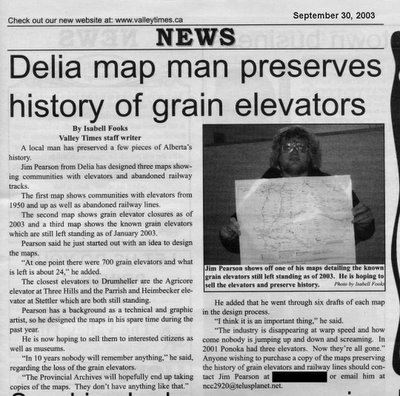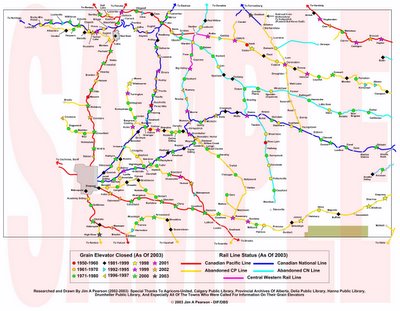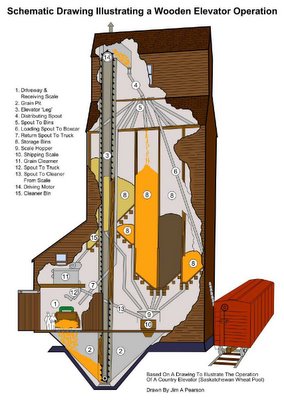My name is Jim A Pearson. I am a graphic artist who has done artwork ranging from Star Trek related starships to military equipment, and my project known as "Vanishing Sentinels" has been showcased in the Calgary Herald and Edmonton Journal.
Here is an article on me from the Valley Times of Drumheller, Alberta from September 30, 2003.

I have been working on this project for the last 3 years. I started after I was doing research trying to find old cemeteries and school locations in my home area of Delia, Alberta. I was in Hanna at the Special Area #2 office, looking at a map of the Area, when I saw a abandoned rail line going north-west from Youngstown to Coronation. After enquiring with the staff, who had no idea there was a rail line there, I started looking into it, and was surprised to find out that there was a Canadian Pacific Rail line which was built as a make work project in 1929, but was torn out in 1931. The tracks were sent way up into the Peace River area for the rail lines up there.
After Delia's big elevator burned to the ground in 2001, and our second last elevator was torn down a year later, I had begun noticing that elevators were disappearing all over the place. So, I decided to do a map of central Alberta showing the past elevator locations, and which rail lines had been abandoned.
Here is one of the original maps, done back in 2003.

From this map, I went on to map out all of Alberta south of Athabasca to the US border, and from Rocky Mountain House to the Saskatchewan Border. This was completed by doing a long long trip thru southern Alberta, from Medicine Hat all the way to the Crowsnest Pass to the tiny hamlet of Del Bonita at the Canada/US border.
Finally this summer, I finished off the map by going way into the north-west into the Peace River country with a friend, and we located as many elevators as we could up there. After we got back, I completed almost everything else by going to Mayerthorpe all the way to Lloydminister in one day (which was one hell of a drive), then south to Paradise Valley, Provost and towns in the East Central part of Alberta.
There are a few areas I have yet to explore, including the area around Grand Centre, Hilda (north of Medicine Hat), the Athasbasca area, and up to the end of the steel at Hines Creek, but I do have almost all of the remaining elevators in the province photographed.
The only ones I am missing are at Boyle (Near Lac La Biche), an abandoned Searle elevator near Duffield (East of Wabamun), Hilda, Inland (located between Vegreville and Ryley), south of Bentley, 2 north of Coronation, and two north of Whitford (near Andrew).
Odds are, there are more out there, but I am hoping anyone who reads this blog maybe able to help me complete this major part of Alberta's agricultural history that has been vanishing before our eyes!
In case you have no idea what a grain elevator is, here is an internal layout of a standard wooden one which used to be seen in almost every town on the Canadian Prairies.

Grain elevators are used to store and transfer grain to rail cars (which were originally made of wood, but now are made of steel), which took the grain to terminals in Vancouver or Prince Rupert, British Columbia, to Thunder Bay Ontario or even to Churchill, Manitoba.
Since the early 1990's, large concrete elevators have been replacing the wooden elevators, and many of the wooden ones have been destroyed out right, or have been bought by local farmers or private companies, or have been abandoned in place.
In the 1933-34 crop year in Alberta, there were 1,755 operating elevators in Alberta. By the 1972-1973 crop year, 1,435 elevators were operating.
By 2005, the number had dropped to a total of 70 operating elevators. The remaining 174 are either operated by private companies, privately owned, are museums, or have been abandoned.
I will be adding pictures of the remaining elevators left in Alberta that I have taken, and more informationabout them in future posts.
The Vanishing Sentinels maps are also for sale. The two maps are on one 44 inch by 34 inch sheet. They show the closure year of the elevators in each elevator town in Alberta, as well as which rail lines have been abandoned, and what elevators and rail lines remain.
If you are interested in obtaining one, please contact me at ncc2920@telusplanet.net
Cheers!